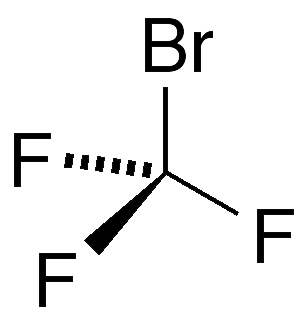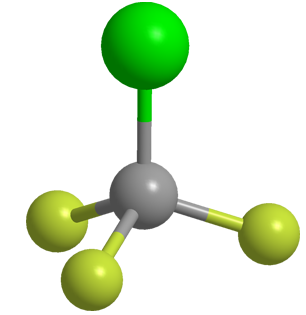What molecule am I?


Bromotrifluoromethane (CBrF3) is a colorless, odorless gas that, under the name Halon 1301 and others, primarily was used as a fire suppressant. It and other bromofluorocarbons were synthesized in 1946 by T. J. Brice, W. H. Pearlson, and J. H. Simons at Penn State, then known as Pennsylvania State College. Their general method was to heat hydrogen-containing fluorocarbons with molecular bromine at 40–50 °C.
Halon 1301 and other halocarbons were used instead of water and aqueous solutions to combat fires in locations where valuable items such as computers and museum pieces would be harmed by water damage. Its extreme health hazards (see the hazard information table) mandated limited human exposure .
In addition to its use as a fire suppressant, CBrF3 was used as a refrigerant; it is also a precursor to the trifluoromethylating agent trifluoromethyltrimethylsilane, the Molecule of the Week for April 12, 2021. CBrF3, however, is an atmospheric ozone-depleting agent; when the Montreal Protocol was instituted in 1989, it and other Halon fire suppressants and refrigerants had to be replaced.
One CBrF3 replacement is 1,1,1,2,2,4,5,5,5-nonafluoro-4-(trifluoromethyl)pentan-3-one1, which, under the name Novec 1230, is a liquid (bp 49 °C) fire suppressant. As with CBrF3, it is used to avoid damage to items of value. A purer form of this molecule, Novec 649, is marketed as a low-temperature heat-transfer fluid.
1. CAS Reg. No. 756-13-8.
Bromotrifluoromethane hazard information*
| Hazard class** | GHS code and hazard statement | |
|---|---|---|
| Gases under pressure, liquefied gas, | H280—Contains gas under pressure; may explode if heated | |
| Skin corrosion/irritation, category 2 | H315—Causes skin irritation | |
| Serious eye damage/eye irritation, category 2A | H319—Causes serious eye irritation | |
| Specific target organ toxicity, single exposure, respiratory tract irritation, category 3 | H335—May cause respiratory irritation | |
| Specific target organ toxicity, single exposure, narcotic effects, category 3 | H336—May cause drowsiness or dizziness | |
| Simple asphyxiant*** | H380—May displace oxygen and cause rapid suffocation | |
| Short-term (acute) aquatic hazard, category 3, | H402—Harmful to aquatic life | |
| Hazardous to the ozone layer, category 1 | H420—Harms public health and the environment by destroying ozone in the upper atmosphere | |
*Compilation of multiple safety data sheets.
**Globally Harmonized System (GHS) of Classification and Labeling of Chemicals. Explanation of pictograms
***Hazard class not included in GHS; no pictogram assigned.
Molecules from the journals
Indium arsenide1 (InAs) is a gray, crystalline substance that melts at 942 °C. It was first prepared in 1953 by French researchers François Gans, Jean Lagrenaudie, and Paul Seguin by fusing the elements. Even then, the authors recognized InAs as a semiconductor.
Fast-forward to this June, when Luca De Trizio, Liberato Manna, and colleagues at the Italian Institute of Technology (Genoa) reported a safer, less costly, more efficient synthesis of InAs nanocrystals (NCs). They used indium(III) chloride (InCl3) as the indium source, tris(dimethylamino)arsine as the arsenic source, N,N-dimethylethylamine as the reducing agent, and—importantly—zinc chloride (ZnCl2) as an additive that helped improve the size distribution of the NCs and passivate the particles’ surfaces. InAs NCs made by this method improved the semiconductor properties of core–shell InAs@ZnSe (zinc selenide) NCs made from them.
Pyronaridine2 is an antimalarial drug that was synthesized by Xianyu Zheng and co-workers at the Institute of Chinese Parasitic Disease (Nanjing)3 in the early 1970s, although their work was not reported in the literature until 1979. It largely replaced chloroquine4, to which malaria-causing Plasmodium spp. had become resistant and became the primary malaria drug used in China.
This May, Bruce H. Lipshutz and colleagues at the University of California, Santa Barbara, reported two syntheses of pyronaridine that are less expensive and have smaller environmental impacts than previous methods. The reaction sequences use water instead of organic solvents, have two or three steps, and have overall yields in the 90% range.
1. CAS Reg. No. 1303-11-3.
2. CAS Reg. No. 74847-35-1.
3. Now the National Institute of Parasitic Diseases (Shanghai).
4. CAS Reg. No. 54-05-7.
Molecules from the Journals
MOTW briefly describes noteworthy molecules that appeared in recent ACS journal articles. See this week's
edition below.
This molecule was suggested by a reader. We present almost all of the molecules suggested by our readers. If you have a molecule you would like us to consider, please send us a message. And thank you for your interest in Molecule of the Week! —Ed.
Bromotrifluoromethane
fast facts
| CAS Reg. No. | 75-63-8 |
| SciFinder nomenclature | Methane, bromotrifluoro- |
| Empirical formula | CBrF3 |
| Molar mass | 148.91 g/mol |
| Appearance | Colorless gas |
| Boiling point | –58 °C |
| Water solubility | ≈0.3 g/L |

Learn more about this molecule from CAS, the most authoritative and comprehensive source for chemical information.
Molecule of the Week needs your suggestions!
If your favorite molecule is not in our archive, please send us a message. The molecule can be notable for its current or historical importance or for any quirky reason. Thank you!
Stay Ahead of the Chemistry Curve
Learn how ACS can help you stay ahead in the world of chemistry.

